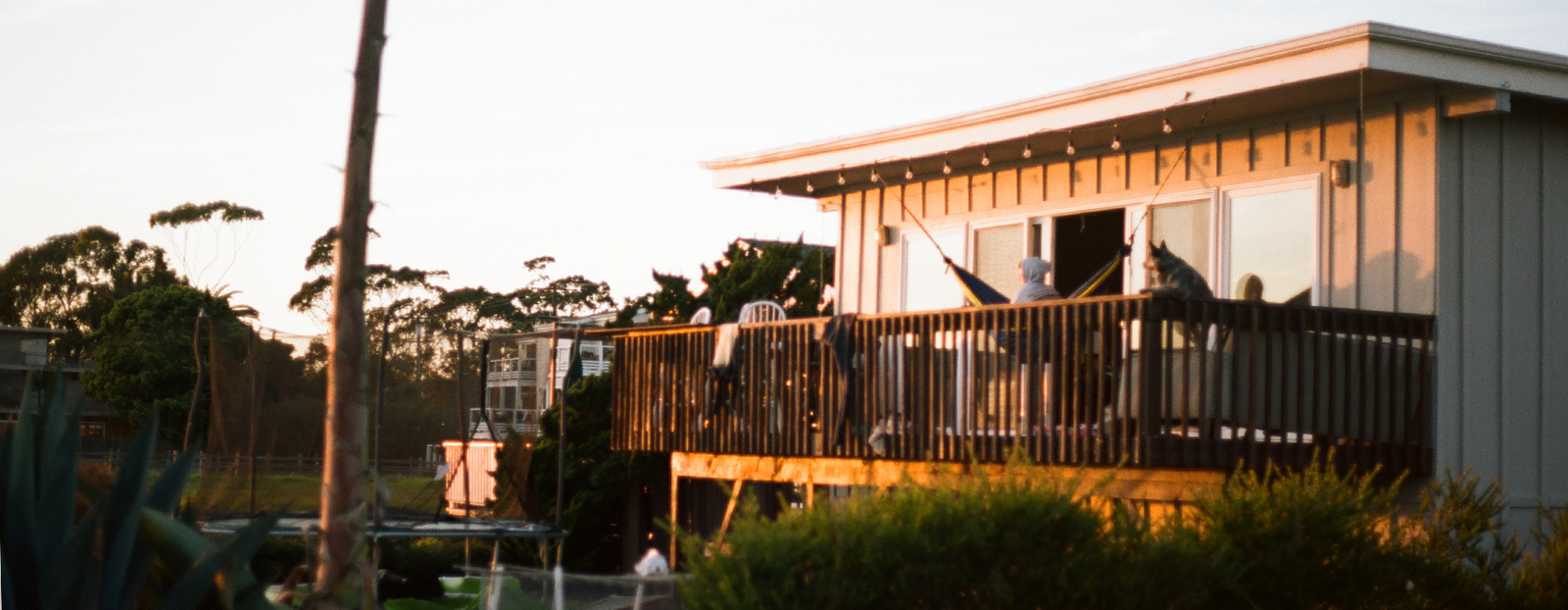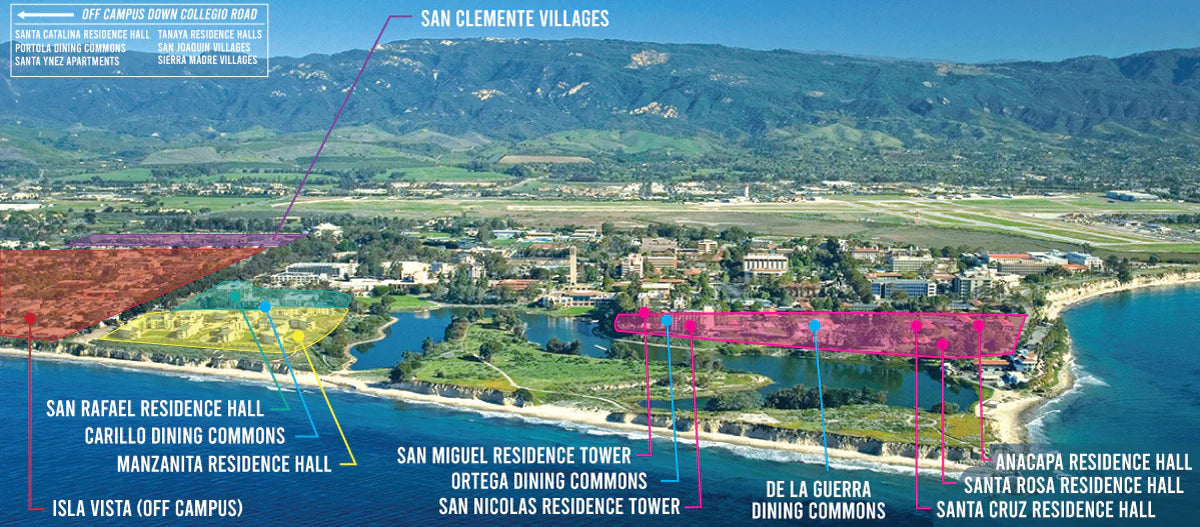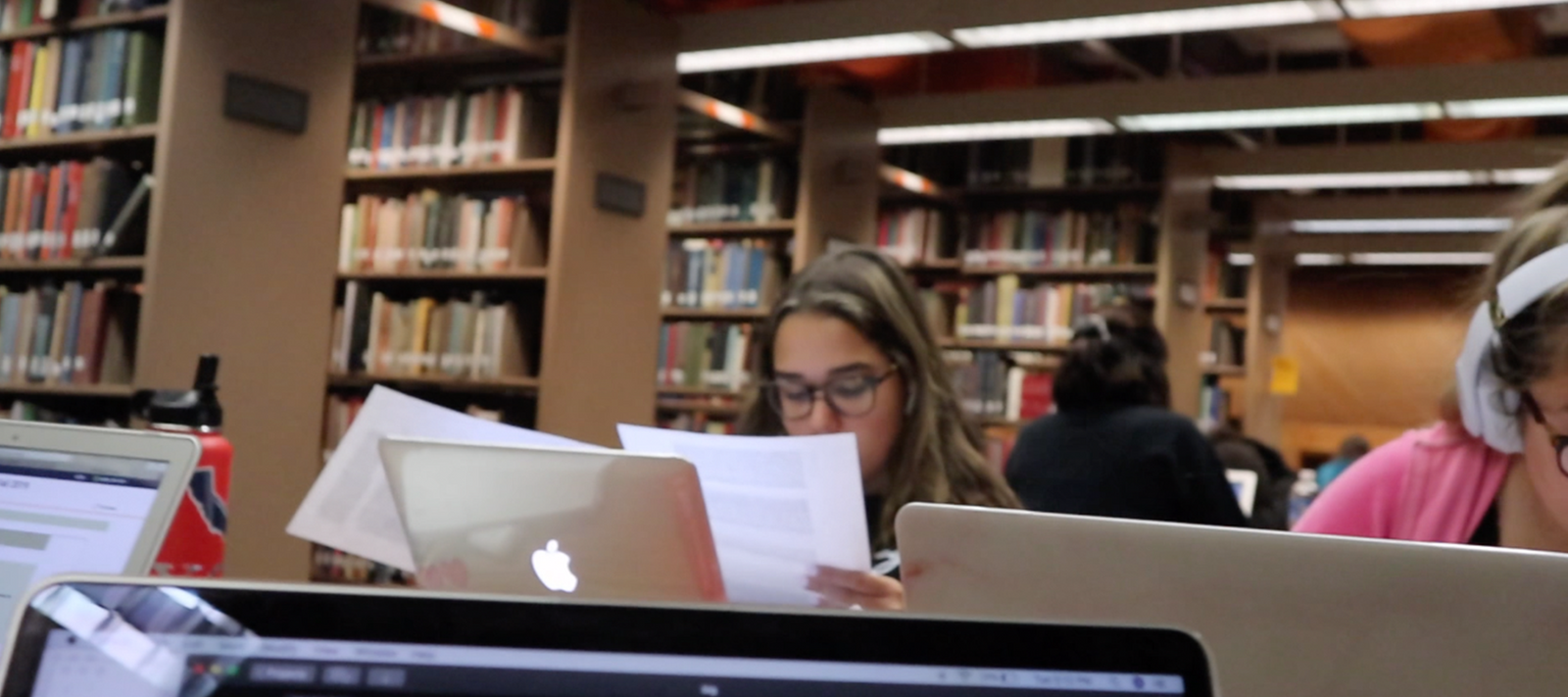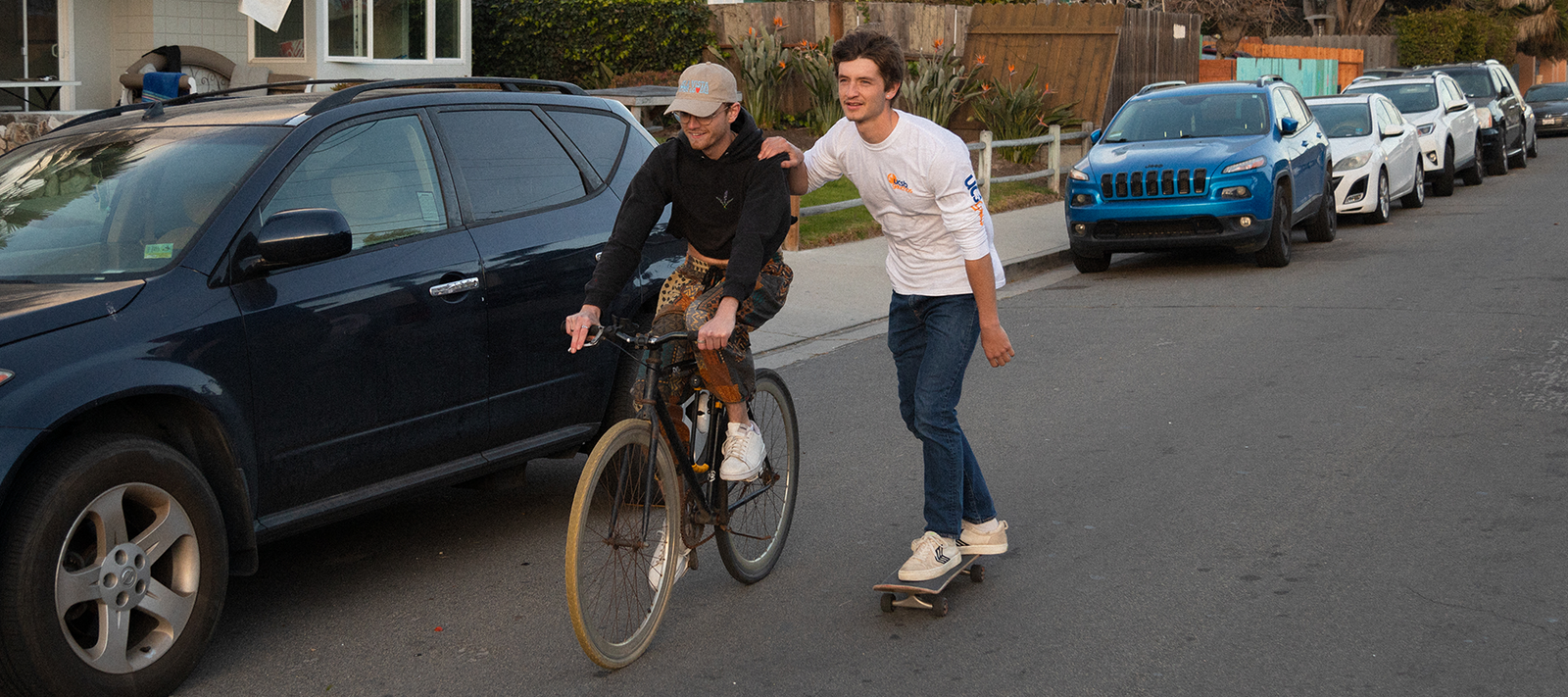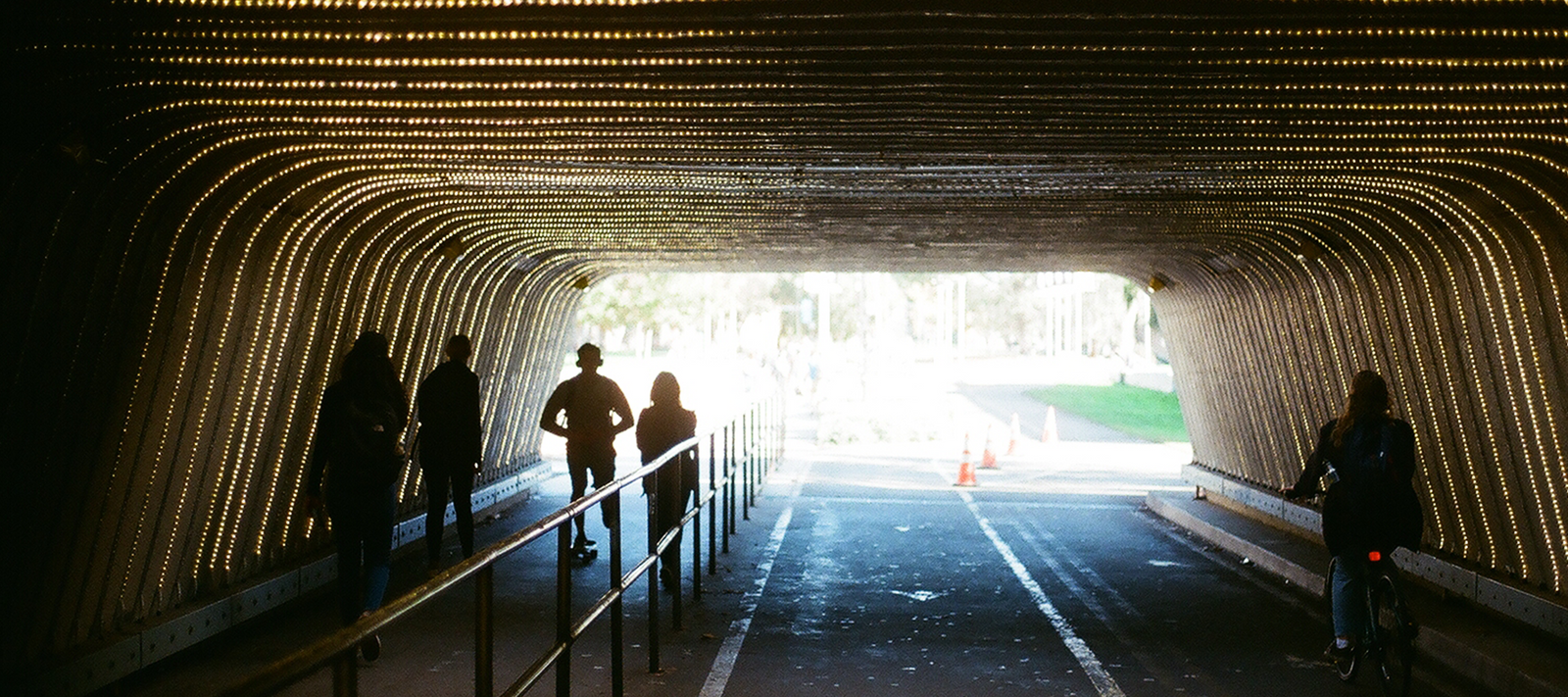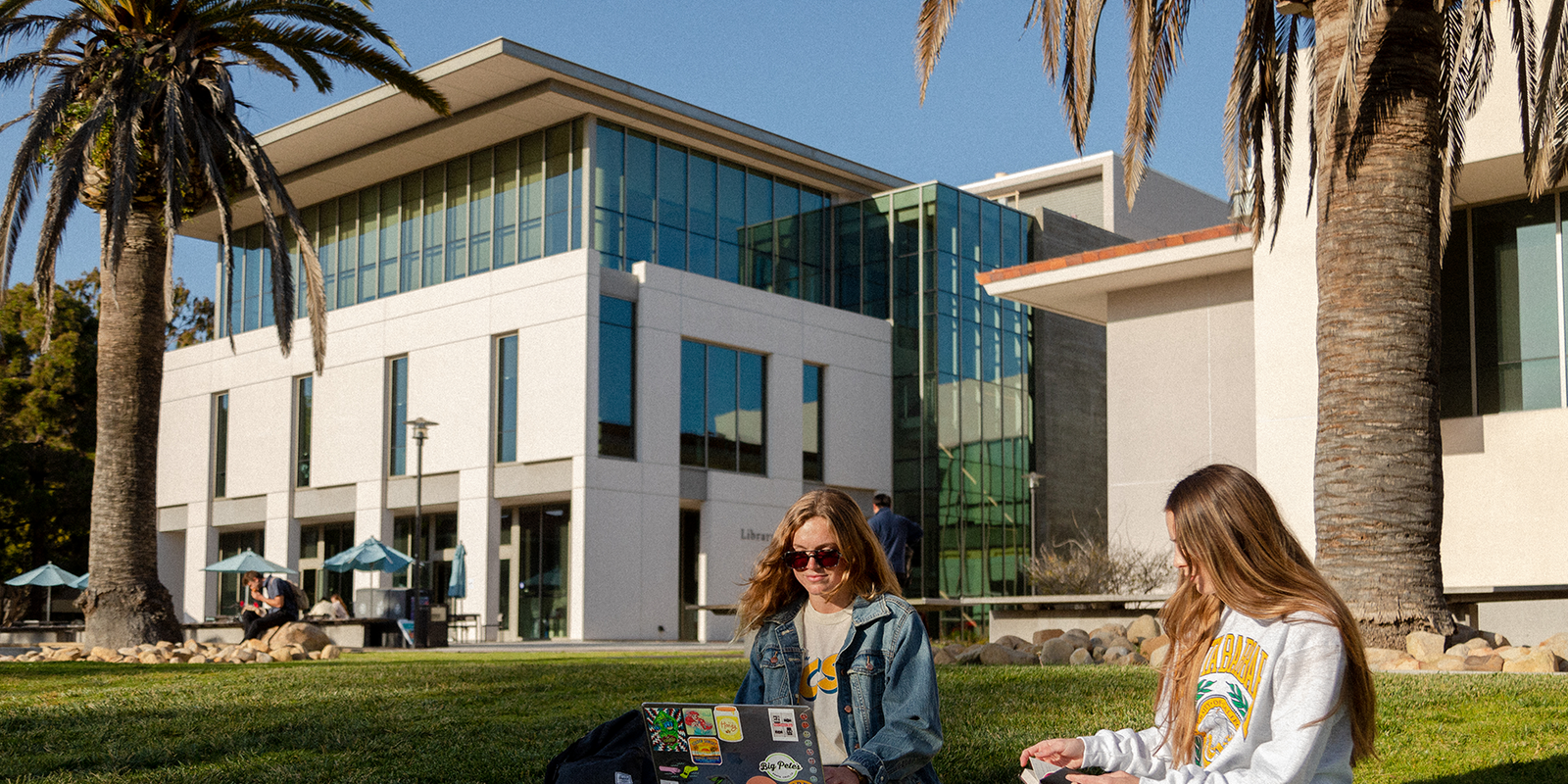Your Cart is Empty
Welcome!
Our store, Island View Outfitters, is located deep in the heart of Isla Vista.
We're two blocks away from UC Santa Barbara and in the center of the Isla Vista electric hubbub, squeezed between a youthful 20,000+ college students living adjacent to campus. In short, we know the ins-and-outs of this place we've called home for over fifteen years (and a place we proudly call the best college experience, ever).
Our print shop and retail store all began in a UCSB student's Isla Vista garage in 2008. Over time, we've immersed ourselves within the community as a business pillar, creative hub, and communal gathering space. We've printed thousands of orders for local organizations, clubs, departments, groups, non-profits, and local businesses.
We've had countless conversations with customers and supporters of our retail store over the decade+ years we've sold our community and collegiate inspired retail goods. Our amazing staff of students and alumni pride themselves as the"outsourced orientation staff"for all things UCSB and Isla Vista.
(*note that this is an unofficial guide for new students on what to expect, but not at all affiliated with UCSB)
Making a decision on where to attend college feels life changing, at the time. Well, it is! You do your due diligence to understand everything you possibly can in attempt to project what your future life might look like. It's inundating. But really... how possible is it truly understand the essence of a place? It's no easy task but be kind to yourself and remember that the decision you make will not solely be based on understanding all the fundamentals in your future life. Some if will, by nature of what the beauty of life is... will be on intuition, feeling, and trust.
Grab a cup of coffee and some spare time because Island View Outfitters' We Gaucho Back: New Student Guide is lengthy, in-depth (and possibly arduous to get through). However, through our collective effort, we've done our best to thoroughly explain some of those questions that may still be unanswered: why UCSB?
All the best,
Island View Outfitters
Topics Covered in this Guide
- Housing
- The Quarter System
- Transportation
- Campus Involvement
- Resources
- Isla Vista Culture
- Food Culture
- Having the Beach as Your Backyard
- Beyond IV
- Finding Your People
- UCSB: A Party School?
- IV Resources
1. Housing
Potentially, housing is the biggest thing we should talk about when entering into the University of California, Santa Barbara. As of now, we definitely would recommend having your housing search/process well underway.
For First Years, it’s a bit easier; First years are required to live in one of the designated campus houses, which we will list all of the houses at the end of this section. Most first year campus housing is located on the UCSB campus, with the exception of two residence halls down the street (biking distance), adjacent to Isla Vista at the corner of El Colegio and Storke Rd.
The residence halls are a great way to meet the people who will either a) be some of your closest friends or b) guide you to finding your group. By way of proximity (all your neighbors in your hall) and programming (hall-sponsored events, school events, or just fun activities), you're able to be immersed in a large group of other first years looking to you as much as you are looking to meet them.
Thanks to the tireless effort of RA’s (resident advisors) and other resident hall staff members, there are countless, inclusive events which offer the opportunity to meet the people who don’t just share a room or a floor with you.
Something else of value, before moving into the transfer student portion of this section, is the knowledge that most of the residence halls are located within relatively close distance to the Dining Halls. We’ll go into more details pertaining to the dining halls later, but we would like to note that the convenience for students offered by the halls’ proximities is something top tier that UCSB has to offer.
Transfer student housing is just a bit different, as transfer students have the option between UCSB housing (both on and off campus) and Isla Vista living. For everyone who is new to the region, Isla Vista is the adjacent region which UCSB opens into. Transfer students are primarily offered housing in Transfer apartments, which are located along El Colegio and Storke Rd.’s. These apartments can range from 4-6 members and are furnished upon entry, and these are full apartments with kitchens, bathrooms, and showers, whereas residence halls rely on shared amenities of these natures.
Should a transfer student choose housing in Isla Vista instead, there are several companies such as Sierra Property Management Company, Meridian Property Group, and more which offer housing from the 65-68 blocks of Isla Vista. Here’s a web page that posts a list of property managers that lease properties in IV, thanks to Pardall Center - a housing resource on Pardall Road, the main street in Isla Vista, just one block from UCSB.
More info on housing optionsIsla Vista Homes
Isla Vista homes, which border the UCSB Campus, are dominantly populated by students and younger alumni and can range, on average, from 4 to 19 residents. The square mile town of Isla Vista is a small community jam-packed with a young, student energy. Depending on which street, you'll find more activity compared to campus housing, due to the variety of concerts, parties, and general events which populate IV on a given day.
As far as rental costs goes, rental units increase in price the closer you are to Del Playa Drive, the street that sits on the ocean bluffs looking out to the Pacific Ocean. A common bucket list item before you graduate that fills the "Isla Vista experience" is to live on Del Playa Drive. Waking up and falling asleep to the ocean waves is an underrated luxury, and, as we all know, the older you get in life after college, becomes exponentially difficult to achieve!
Residence Halls
IVO's Top 5 Freshman Residence Halls
- Anacapa Residence Hall
- Santa Cruz Residence Hall
- Santa Rosa Residence Hall
- San Nicolas Tower
- San Miguel Tower
What You Should Know About Each Residence Hall
The "shorties" or “CHI-5” area on campus, short for the Channel Island 5 are a cluster of residence halls between Campus Point, the UCSB Lagoon, and Davidson Library. It consists of 3 residence halls (our top 3) -- Anacapa, Santa Cruz, Santa Rosa -- that are two stories tall with four separate wings. The other two are towers -- San Nicolas and San Miguel. There are two close dining commons, De La Guerra and Ortega, that are walking distance that have great variety of food between the two.
Santa Cruz Residence Hall
The most newly renovated residence hall has a movie theater room with fun events involving chocolate fountains, old school popcorn makers and more. This hall is the closest to campus point beach and a beautiful lagoon view.
Anacapa Residence Hall
Due to it being two stories, it feels intimate and easy to get to know most people. You’re 100 steps from the beach, a close walk to sunsets at Campus Point, and can pick and choose between two dining commons, so you don’t get sick of eating the same food. You can get to class in 5 min, so waking up 10 minutes before your 8:00am class is entirely possible!
Santa Rosa Residence Hall
Probably the most social, fun hall. Very outdated furniture and carpet wise. It also has its own small gym so if you don't want to walk across campus to the Rec Cen, don't fret! Won't reveal our sources but it also has the best water pressure in the showers.
Santa Catalina Residence Hall (formerly Francisco Torres)
If you enjoy biking or taking the bus, FT is the place to be! It's located next to the best dining commons, Portola, and ocean views from the North Tower. Unlike the "CHI-5" residence halls which have triples with communal bathrooms, Santa Catalina have doubles with Jack-and-Jill bathrooms.
While most folks at IVO advocate for the CHI-5 experience, Santa Catalina has it's own great benefits. The density of students allows for amazing opportunity to meet a ton of friends. The largest residence hall, it also offers amenities like a pool, fitness room, volleyball and basketball courts.
San Rafael Residence Hall
San Rafael is a seven story tower with ocean and lagoon views. The four-person suite has a large living room and large bathroom with only one shower for additional privacy. It feels much more like an apartment and not at all like a freshman hall.
Manzanita Village
Manzanita is difficult to get into since it houses other grades besides freshmen, but definitely is the nicest most modern of the residence buildings. If you value your privacy and enjoy the finer things in life, you'll love the quaint family-style 3-4 story buildings with a shared kitchen, living space, and study room, There is also a private gym and study building with more private rooms that are only accessible for Manzanita village residents.
A great part of Manzi is that they have big, lockable single bathrooms (about 3 per floor of 15 residents) which allow you to have more privacy compared to the large shared bathrooms of Anacapa or Santa Rosa. Location wise, Manzi is right on the ocean, is a bit tucked away from the other freshman halls, but is the closest to Isla Vista where most other students live! You would be closer to restaurants, coffee shops, parties.... Anyways. The only downside (or possible up-side for introverts) of Manzi is that it is known for being a less-social, more quiet residence hall.
Tips for Transfers (ft. Brock Clark)
Brock Clark transferred to UCSB in Fall 2017. Brock is our longest standing team member, starting as a retail associate in 2019. Since, he's Sales and Operation manager in our custom division, and liaison to our retail team.
Sierra Madre and San Joaquin Villages
These have THE BEST kitchens. It’s super easy to avoid the Transfer 20 (same as the Freshman 15) if you live in either of these locations. The amenities are super nice here outside of just the kitchen; these apartments come fully furnished and are fairly new, which is a big win as far as wear and tear is concerned. Another pro for either of these locations is the proximity you have with other transfer students; it’s super easy to get acquainted with one another and most of the people here are looking to do just that.
One major con for these locations is that it is a trek and a half to get to campus. These spots are somewhat isolated and it really forces you to make the effort to commute to UCSB/IV in order to get to class on time and have a social life. I can assure you, however, that riding your bike from El Colegio and Storke on a windy day will get you in the best shape of your life.
Santa Ynez
I found this set of apartments to be as close to cozy as you can get as a transfer student. These have been renovated somewhat recently but they still maintain the 90’s UCSB aesthetic. This set of apartments is also closer to UCSB/IV than Sierra Madre and San Joaquin, so it’s much easier to get to class, restaurants, and friends houses from here. he major downfall here is the parking - which also goes for Sierra Madre and San Joaquin - as there is minimal parking compared to the amount of students who live here. best suggestion is to get ready to bike, board, and bus.
El Dorado and Westgate
Prime for transfer students mainly because they are in IV and they offer not only double, but single bedroom apartments. These will nabbed quickly, as the majority of other transfer apartments do not offer single bedrooms. These apartments were renovated from older apartments and with that history comes just a bit more wear and tear, but the university is there to assist you if anything comes up. For transfers who might feel more inclined to get their feet wet in IV the minute they get boots on the ground, this set of apartments is prime real estate.
Additionally, we'd like to take the time to talk about how a transfer student might go about finding housemates and a roommate coming into UCSB.
This process can be nerve-racking but it doesn’t have to be. Back when I was accepted into UCSB, all transfer students were encouraged to sign up for an app where we were able to ask each other questions about housing choices, financial aid, and major work. We were also encouraged to find people we thought were suitable matches for housemates and roommates and then to message these people to try and make that work. Sometimes it works out great and other times you find out that they already have a roommate or a full house, which happens, but there’s always somebody looking for housemates here.
My personal suggestion would be to join a Facebook group or another social platform page of fellow admitted students or follow the respective Instagram in order to meet and message people about potentially living together. Sometimes, it’s super difficult to find people who are coming in without other friends or who don’t have roommates already set up, which is what happened when I was coming into UCSB. At this point, I just found the best room I could and prayed for solid roommates, which I was pleasant to find I had. They all were actually really awesome and the whole idea of living with people who you know nothing about, which can be scary, is also somewhat exciting.
Acclimating as an Athlete (ft. Emily Johnson, Women's Soccer)
Emily Johnson is a 2023 graduate who played on the Women's D1 Soccer team. She is now an account manager in our custom apparel division.
Being an athlete at UCSB was such a special experience! The athletic program provides athletes with a network of other students living similar lives to create a place of friendship and support. Not only does being an athlete bring you closer to your own teammates, but serves as a place to meet other athletes and make friends outside of your own program. The student-athlete community is fairly tight knit allowing you to expand your social network into other teams and other sports.
Depending on your program and the season you compete in, you may be required to arrive on campus earlier than the start of fall quarter. While Fall quarter generally starts in September, student athletes (in my experience with soccer) are required to arrive as early as July to begin training. The summer served as a transition period to acclimate to my new environment and become more comfortable with my new life. By the time September rolled around and the rest of the first years arrived, I already felt like I had a great understanding of general lifestyle, lingo, and way of life.
Majority of freshman athletes live at Tropicana Gardens aka 'Trop'. Trop is a three-story residence hall located on the corner of El Colegio and Camino Pescadero in Isla Vista. Trop has a convenient location, as it's closer to campus than FT and closer to Isla Vista than on-campus housing, serving an in-between to make almost anywhere on campus or in IV easily accessible.
The living situation at Trop is unique, as the rooms are ‘suite’ style: multiple bedrooms, multiple bathrooms, and a common area in each room. This style provides a common area to hang out outside of your bedrooms, while still having the privacy and enjoyment of being in your own room. Additionally, Trop has its own dining hall for its residents. As the other freshmen have access to the multiple dining halls across campus, Trop residents are restricted to the dining halls inside Gardens and Tropicana Del Norte (the ‘sister’ hall a block down). If you are lucky enough to have a good friend living in a different freshman hall with a dining pass, they can swipe you in for a meal or two to enjoy a Portola brunch that will feel like a five-star meal. In my experience, I've found other dining commons to be better than the food at Trop, but let's just say... you eventually find a way to make it work.
Being an athlete is demanding. Your time is often spent with your teammates or with other athletes in Trop. While other first year residence halls are packed with social programming that allows students to meet a lot of people, being a student athlete feels a bit limiting. Be prepared to take your own initiative to explore other social opportunities to make friends outside of the athlete circles.
I rushed and joined a sorority where I met amazing people and friends, in addition to a few UCSB clubs that sparked my interest. Becoming friends with others from different groups only enhanced my overall UCSB experience. It may be hard to put yourself out there, but always remember that there are many first years around you who feel the same way. Additionally, people will love to meet you, as many students are fascinated by the student athlete experience.
To touch on the student in student-athlete, it is always important to stay organized and on top of your school work. Being on a team requires travel and the potential for missing classes. Always check your calendar at the very beginning of the quarter and communicate with your professor on the first day of classes to discuss any scheduling conflicts that practice, games, or travel may cause. Some professors are willing to work with you, while others may tell you the work you miss may not be able to be made up.
During my freshman year, I ended up needing to drop a class and rearrange my schedule due to the team's travel schedule. Remember that this may happen, but there are resources and advisors that can help you with these conflicts. Need to focus? Here's my pro-study tip: utilize the ICA Study Hall. Many sports programs require mandatory study hours for a freshman's first quarter of school, but even after my hours were over, it became a place I would utilize almost daily. It is a great place to go in between classes or practice when you don’t have time to make it back to your room. Study hall is a great place to utilize during Midterms and Finals Week, as the library is often gets overcrowded. Overall, being a student-athlete is an experience that many Gauchos do not get to experience, so take advantage of the special experiences that come with it.
2. The Quarter System
Something which might get overlooked coming out of high school or a community college is the transition from semester-based schooling to the Quarter System. It’s not a completely daunting task to transition from one to the next, but we advocate preparedness first and foremost.
The first thing you’re going to notice in the quarter system is that things will, likely, be going by a lot faster than you were expecting them to. Reading three to four novels in a philosophy class in one semester will be toned down to one to two, but these are going to provide the bulk of in-class language and concepts, which will then be used on quizzes and tests, so we advocate actually reading the assigned pieces. Also, articles are going to be big here, expect to see a lot of those on Gauchospace, the online site which most professors and TA’s prefer to run their class assignments and announcements through.
Gauchospace
Gauchospace is pretty easy to get the hang of; the website is easy to navigate and you can do such tasks as check grades, turn in assignments, and take quizzes - just to name a few. By Week 3 you should understand this system pretty well. We’d also like to point out that the quarter system is 10 weeks long, with the last week considered Dead Week.
Dead Week
Dead Week is used for wrapping up final papers and studying for finals. Before this week hits, we highly recommend you get stuff like grocery shopping and laundry out of the way, as this is typically a high-maintenance week. Rest assured, countless Gauchos have survived before and we have the utmost faith that you all will as well.
Selecting Classes
Something we don’t want to forget to mention is that you have to pick your classes for subsequent quarters during weeks 4-6. During this time period, you’ll receive 3 pass times, where you can accumulate classes and their corresponding units. Each pass time will be about a two-day period and you’ll have a unit maximum that you can add each time, this means you will be able to only get a certain number of classes per go. 12 units classifies as a full course load in the UC quarter system (a standard class is 4 units: a 12 unit quarter = 3 classes) and while you might not be able to get all the units you need to get in your first pass time, you should be able to on the second go.
It is worth noting, too, that classes fill up relatively quickly and you might have to make some adjustments to your schedule. More times than not, we can state that most of us had to change our schedules based on class availability and unit/pass time restrictions, but we’ve all made it through and you all will be able to as well.
'Crashing' a Class
Afraid that you didn’t get into a class because it was full during your pass time? Crashing a class at the beginning of the quarter is standard. There’s hustling and shuffling that happens during the first or second week of the quarter. Make sure you reach out to the professor as soon as possible via email showing your interest in the class. Make sure you arrive on time during the first week to classes you ‘crash’.
3. Transportation
Transportation is a big thing to understand coming into UCSB, so let’s get to it! One of the biggest questions parents and incoming students alike ask: is a car needed? The general consensus you'd get from the majority of folks: absolutely not.
A bike or skateboard is highly recommended to get around both IV and campus. Trust us, while some people don’t mind footing it, you don’t want to walk from 65 block to 68 block in IV when the weather is turning and it goes from being 80 degrees all day to 55 and windy at night. Either of these two options will for sure help out, but if you want, you can also use one of the electric scooters-by-the-minute that are just floating around IV. All you need to do for those is download the app and scan the QR code and you should be set to go - just remember these are usually unavailable from 2AM to 7AM.
The big difference between the rentable scooters and the more permanent options, like bikes and skateboards, is that rentable scooters are not currently allowed on campus, and if you are caught riding one on campus you can be sure to receive a fine. We would also like to point out that we have a fully developed guide to biking which we will link at the end of this segment.
A final word of wisdom would be to mind the buses. The buses are constantly running and your student access card (with your Student ID, you ride free) is all you need to hitch a ride. The bus destinations range from Campus and IV all the way to Goleta and Santa Barbara. We highly recommend getting the MTM App for routes and up to date data on the buses. As far as getting to areas such as Target, Costco, and Albertsons (all located in the Storke and Hollister regions), taking the #27 and #28 busses are definitely the call. Also, we highly recommend making sure you know which buses stay solely in IV, because it would not be fun to wind up in downtown Santa Barbara by mistake.
Swinging back to the car question: what are the benefits to a first-year having a car? Outside of just ease of access around town, as well as the ability to commute to work or back home, not much. Most of your first-year life will consist of spending time in the residence halls, studying on campus, eating at the dining commons, and heading out to Isla Vista by foot/bike/board for some food, social activities, or other events.
There may be a few times here and there it is important to run over to Target or Costco, however, it doesn’t justify the cost of a car, a car permit, and/or the risk of parking it in Isla Vista, which is already compacted enough with cars. Must supplies are easily purchased at markets in Isla Vista (support local!).
4. Campus Involvement
Campus involvement at UCSB is, much like the student population: relatively diverse. UCSB does a great job providing a space in which students can learn and grow outside of just a textbook.
Clubs
Some of the mainstream areas of involvement revolve around the bevy of clubs presented within specific majors. A few examples of this would be the Screenwriting club within the Film and Media Studies major as well as IEEE for Electrical and Computer Engineering students.
As far as major-specific clubs go, we highly recommend that you search within your classes by asking fellow students, as they potentially overheard or were introduced to some of the clubs you have yet to hear of. Chances are, you will also be introduced to clubs within your major thanks to in-class announcements often presented by members of these clubs.
If you’re seeking a club atmosphere that isn’t necessarily restricted by major, there are a wide range of clubs throughout campus that aren’t tied to one specific major. Some clubs to keep in mind include Improvability, Ultimate Frisbee Club, and Fencing Club.
A good way to be informed of club opportunities can be found via Kiosks posted throughout campus. These are usually dressed to the brim with everything from club invites to work opportunities, such as tutoring or even babysitting. These Kiosks can be found everywhere on campus, but it is also important to keep in mind the advertisements throughout The Arbor and the University Center, which we simply have dubbed The UCen — we abbreviate almost everything here, just some unwarranted advice that seemed pertinent right now. Anyway, the UCen and Arbor are great for meeting people and getting club information quickly; however, any UCSB student or alumni will recommend a pair of headphones at the arbor, as this is a site where unwarranted solicitations are rather frequent.
Additionally, the Campus Involvement Fair is usually held at the beginning of each school year at Storke Plaza, between Storke Tower and the UCen. Here, you can find aa wide range of clubs tabling, eager to welcome you to the school.
You'll obviously find some good resources through UCSB's Getting Involved page, which will direct you to the list of groups on their Shoreline Resource page, allowing you to sort, explore, and fid the purpose of each group!
5. Resources
The Library
The eight floors of UCSB's Davidson Library, are a second home to most students. Davidson is an architectural beauty, which includes 360 panoramic views of the mountains, ocean, and Santa Barbara sprawl.
The way the library works is as follows: 8 floors total, 4th is usually where most people hang out, and the higher you go, the quieter you’re supposed to be. If you open a bag of chips on the 8th floor, you might never be welcomed there again.
The library offers a range of resources outside of merely checking out books, and these include but are not limited to print stations, reservable study rooms, a cafe, and several water bottle filling stations. The library staff are well-versed in assisting the student body and we highly recommend turning to them if you have any needs ranging from specific title acquisition to research assistance.
Many of the majors have a library technician assigned to them and it might be worth your while to check with academic advisor or teachers to see who this is. They will be informed about the location of and titles within your major’s collection at the library.
The UCen
Briefly mentioned earlier, the University Center is at the center of campus, just across from Storke Tower, and operates a hub for day-to-day life on campus.
The UCen has everything from restaurants and a Print Shop to a bookstore, which is useful for getting textbooks quickly and grad gear when it comes time. The UCen is a great spot to mellow out for a bit between classes while grabbing a bite and taking in the scenic view, as the back side of the UCen opens into the UCSB Lagoon and Campus Point, which offers a sweeping panoramic of the ocean. It’s also worth mentioning that there is a post office located on the bottom floor of the UCen, which are mailboxes assigned to various groups of the campus, such as transfer students.
CAPS
CAPS stands for Counseling and Psychological Services and is UCSB’s onsite department which takes on the responsibility of students’ mental health.
CAPS is a terrific resource due to the fact that the changes taking place during one’s time in college, both personally and professionally, are ones which shouldn’t be navigated alone. CAPS offers a safe environment which aids students in a manner of mental health related subjects. If the office or appointment sheets are relatively full, which they are rather often, we recommend asking the receptionist for a list of potential therapist options.
These resources are designed to be for the betterment of one’s emotional and mental functions, and we cannot express enough that the campus of UCSB operates a safe space for various identities and mentalities. For more on CAPS and the services they offer, we recommend viewing their website, which we have linked at the bottom of our resources section. CAPS is located along the main thorough fair of campus and is located at Building 599, just across the bike path from Storke Tower.
CLAS
CLAS is UCSB’s Campus Learning Assistance Services. At its core, CLAS provides tutoring and education resources which empowers students to take their learning practices to the next level. CLAS has a range of tutors and staff members who are geared at assisting students in graduating to the next rung on the educational ladder.
Chances are, a TA of yours might recommend seeing CLAS for some guidance on some of your bigger projects, as the students who work here have likely been in your shoes before. CLAS also offers an excellent opportunity for work and resumes should one be well-versed enough to teach a subject. CLAS is located within the SRB, or Student Resources Building.
SRB
The SRB operates both as resource establishment and study space for students. The function of the SRB is to offer students a plethora of resources not always available to students in a hands-on manner. Some of the various departments and centers in the SRB include the Office of Judicial Affairs (OJA), the Department of Women, Gender, and Sexual Equity (WGSE), and the Middle Eastern Student Resource Center (MERC).
The SRB also has printing options for students as well, and given its location right next to IV, comes in handy for students in a hurry to print while on their way to class. The SRB also hosts a range of workshops under the Office of Student Life (OSL), which is important to take note of if you are a part of any of the various fraternities and sororities, as these groups are required to go to several of these workshops.
Student Health
UCSB Student Health operates like a miniaturized version of a hospital. With admission to UCSB, you are automatically eligible to be a part of the UCSB Student Health network, and, depending on your insurance or financial aid, the costs can be charged to your BARC account.
At student health, you can be checked out for anything from minor to major symptoms, and the facilities onsite can take care of several different health needs, which include but are not limited to STI testing, blood tests, and pharmaceutical fills and refills. Student Health is located across from the University Track at the North entrance of campus, just off of El Colegio.
Dining Halls
As mentioned earlier, the dining halls are scattered throughout campus and are a quick way to get the meals you need to make it through the day. The dining halls at UCSB are Ortega Dining Commons, Carrillo Dining Commons, Portola Dining Commons and De La Guerra Dining Commons.
These are open to all students with the purchase of a meal plan, which range in price by the option selected. While these are open to any and all students, they are initially aimed at first- or second-year students who live in residence halls and have limited options in terms of cooking for themselves.
Rec Cen
The UCSB Rec Cen is the perfect place to blow off steam and stay in shape. This is just off of Ocean Rd. and is situated behind Robertson Gymnasium. The Rec Cen has two gyms, the main gym and the MAC (Multi-Activity Court) and offers everything from personal training (for a fee) to intramural sports opportunities.
The Rec Cen also houses the Adventure Program, which, for a fee, allows you to rent equipment, such as kayaks, or join excursions, such as hikes and the like. Students are automatically given a UCSB Rec Cen membership once their BARC account is paid off for the quarter, and for non-students, there are generally discounts to join the gym. The facility itself also includes two pools, several outdoor fields, a bevy of tents courts, and a world-class rock climbing wall.
Resource Connections
UCSB Library: https://www.library.ucsb.edu/
UCSB UCen: http://www.ucen.ucsb.edu/
UCSB CAPS: http://caps.sa.ucsb.edu/about-us/about-caps
UCSB CLAS: http://clas.sa.ucsb.edu/
UCSB SRB: http://www.sa.ucsb.edu/student-resource-building/home
UCSB Student Health: http://studenthealth.sa.ucsb.edu/
UCSB Dining Services: https://www.housing.ucsb.edu/dining-services
UCSB Rec Cen: http://recreation.sa.ucsb.edu/
Click here for Part 2














